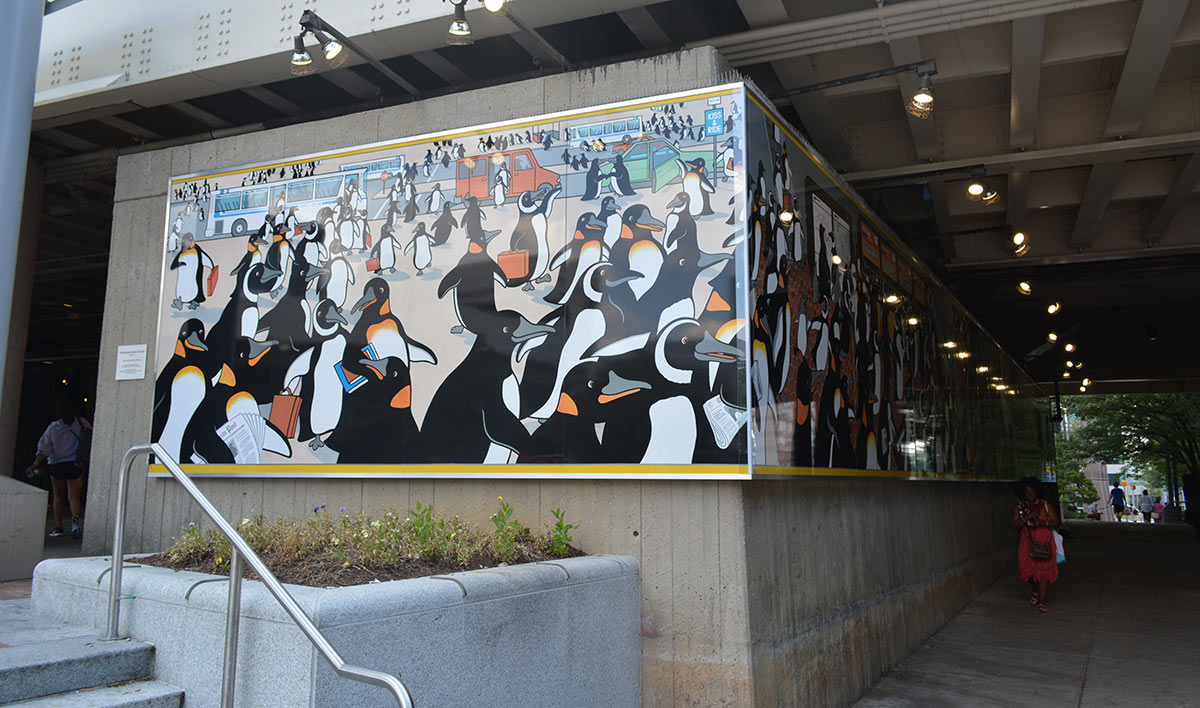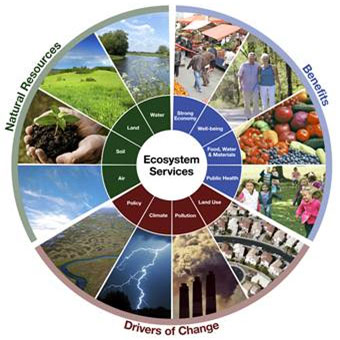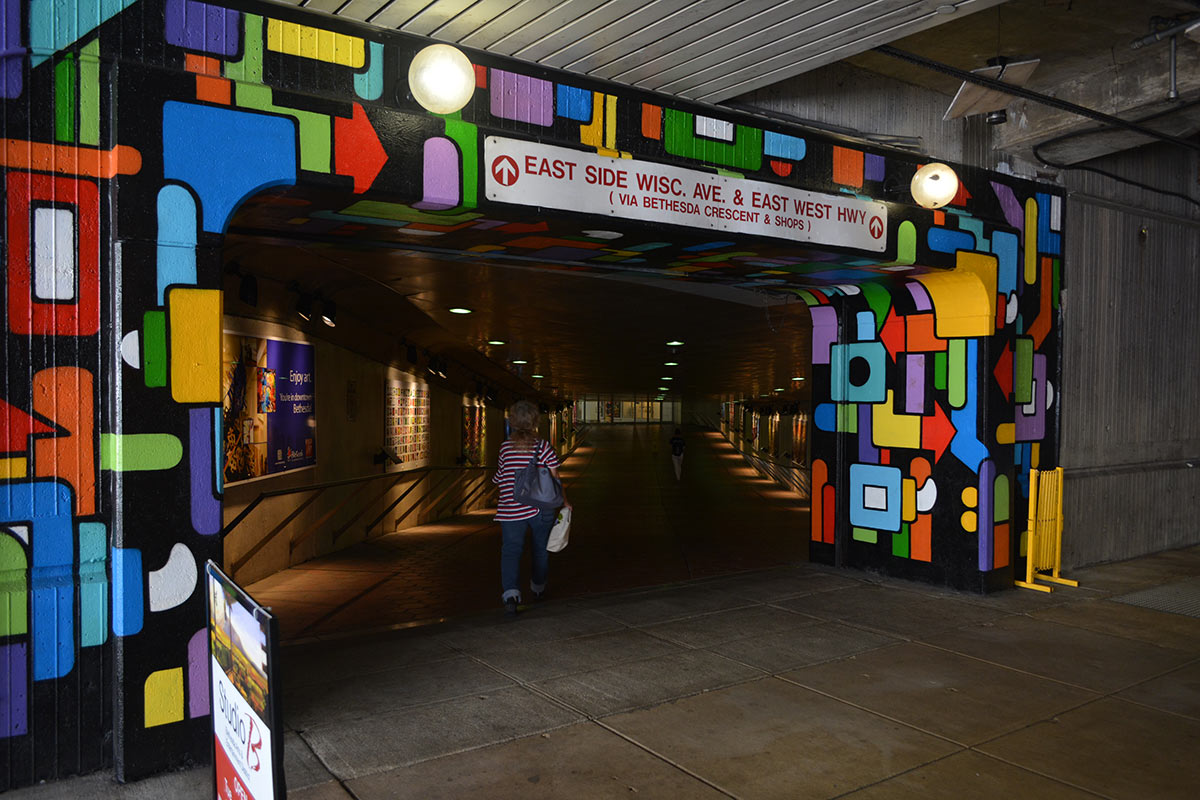As our county continues to become more diverse, public art can fill a uniting role in bringing communities together

Penguin Rush Hour (Artist Sally Callmer, 1990)
The Wheaton, Silver Spring and Bethesda Metro stations have pieces of public art that are hard to miss. The installation of Penguin Rush Hour (pictured above), Tunnel Vision or Beacon I will likely stop you in your tracks while you wonder: “How did this artwork get here?”
Penguin Rush Hour by artist Sally Callmer was originally created as a temporary public art installation at the Silver Spring station in the 1990s. However, the community united to raise money to repair the artwork and make it permanent. The penguins were so much a part of the community’s identity that Silver Spring decided to make the penguin the city’s mascot. Penguin Rush Hour is now a symbol of Silver Spring and these black-and-white birds can be spotted, through art, all over the community.
This proves public art can inspire a community, therefore it is worth preserving as our communities evolve demographically. The ownership of public artwork by the community continues to pose important questions. For instance, how do we define public art in Montgomery County? How can we continue to engage our audience and make public art more inclusive? Where is the intersection between public art, placemaking, and the Planning Department’s Design Excellence initiatives? What places will attract the next generation of artists?
These are the questions that spark creative thoughts about how regulations and visions can begin to support healthy public art ecosystems.
What is a public art ecosystem?
 Natural ecosystems are organized into three categories: resources, benefits and change agents. Within each category are multiple layers or micro-systems that ultimately contribute to the end goal.
Natural ecosystems are organized into three categories: resources, benefits and change agents. Within each category are multiple layers or micro-systems that ultimately contribute to the end goal.
Public art ecosystems aim to produce artworks that reflect a strong community. The resources are the people and materials used to produce the artwork. The benefit of art in the public realm is calling attention to economic, health or social issues. The change agents are the underlining structures or frameworks used to encourage the growth of public art.
Public art ecosystems in Montgomery County should not only strengthen the basis for a more comprehensive planning process, but should also make art in the public realm more accessible to everyone. The first step in accomplishing this goal is to understand the community.
The most essential resources to any successful public art project continue to be the people who visit the space frequently. Their feedback provides insight on the intended audience that will be experiencing the artworks.
Montgomery County’s population is now more than 1 million after the 2010 Census showed 7 percent growth (an estimated 67,542 people). The county’s 3.1 percent unemployment rate is well below the national average and 59 percent of all residents 25 years or older hold a bachelor’s degree or higher.
The county’s ethnic populations are shifting too, with the largest minority group coming from El Salvador. These statistics are strong indicators that the primary audience is well-educated and diverse.

Tunnel Vision (Bethesda Urban Partnership, 2012)
As Montgomery County becomes more diverse in population, some residents may become more and more resistant to change and may even start to feel like outsiders in their hometowns. It is at this point when the public artist is presented with the challenge of bringing people together to heal the divide within the community. The culture of the community, in turn, provides inspiration to the artist.
In an effort to support public artists, strengthen public-private partnerships and encourage private developments to support community identity, the Planning Department and the Arts and Humanities Council of Montgomery County (AHCMC) have joined forces to create a more vibrant and inclusive public art ecosystem. That collaboration led to the creation of a public art inventory map that identifies all the public artworks throughout the county and provides linkages to all the municipalities.
Today, Montgomery County’s collection of public artworks comprises more than 800 installations. Through public-private partnerships (known as “P3s”) and the private development entitlement process, roughly 60 percent of these artworks were created and installed in the late 1980s and early 1990s.
Beacon I (Artist Mary Ann E. Mears, 1985)
Of the publicly and privately funded artworks, more than 75 percent were provided by private developers and clustered within the county’s arts and entertainment districts, including downtown Silver Spring, Bethesda and Wheaton.
After taking inventory of the existing artworks, new policy documents were created to clarify the review processes. These documents primarily articulated the important role that public artists play in development. The Public Art Roadmap (created by the AHCMC in 2016) set forth the vision for public art throughout the county.
The revised Public Art Guidelines (originally approved and adopted in 2013) provide countywide guidance for commissioning and maintaining publicly funded public art projects. The Art Review Panel Policies and Procedures, updated in 2018, address development phasing and manage expectations in private development.
These policies recognize that the best art projects engage the viewer, convey a strong sense of the community’s identity and involve artists early in the development process. By shifting our focus to more densely populated communities planned around transit, streamlining the regulatory process and promoting the Design Excellence initiative, our public art ecosystem will elevate the quality of buildings and public open spaces in new ways. Our challenge will be to produce memorable artworks that engage residents of all cultures and backgrounds, and help them to better understand their roles within the community.